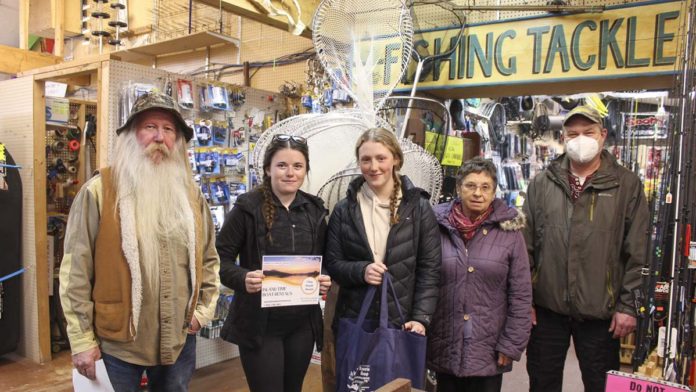MANITOULIN—In mid-February, Escarpment Biosphere Conservancy (EBC) received an additional $3 million from the government to spend by the end of March. The organization met the challenge by purchasing seven additional nature preserves, including four on Manitoulin Island.
Two of those are going to be very good for hiking, said EBC executive director Bob Barnett. One is the Lewis Twin Peaks property, which has long been a hiking trail. “The owner agreed to sell it to us at a reduced price because she loved the fact that we were going to keep it open as a hiking trail,” said Mr. Barnett.
The other is a 360-acre property located on Lake Wolsey, west of Gore Bay. “It’s on the east side, where the causeway goes across to Evansville,” Mr. Barnett said. “There’s a couple kilometres of Niagara Escarpment there with beautiful cliffs. There’s quite a bit of shoreline and there’s literally cliffs going down to the water. That’s going to be a pretty important place for people to visit.”
Two additional properties were acquired, “but they’re not going to be quite as successful for hiking,” he said. One is located on the south shore of Lake Huron at Green Point, near Purvis Fisheries. It is located east of EBC’s existing Green Point property in Robinson Township. The other is an interior forest tract near Silver Water and adjoins the shoreline protected by Queen Elizabeth the Queen Mother Mnidoo Mnising Provincial Park (Queen Mum Park). “They’re not likely to be quite the same tourist attraction.”
Tourism is one of the benefits of EBC’s nature preserves, he added. “We’re providing $34 million of what I call nature services, every year.”
What are nature services? “Nature services are things like providing cleaner air and cleaner water. It’s very hard to visualize. I’m taking my figures from an Ontario government-commissioned study that talks about $84 million worth of services that nature is providing in southern Ontario. Our piece of that is $34 million.”
Mr. Barnett said that EBC reserves have sequestered 750,000 tonnes of carbon dioxide from the atmosphere. “That’s a lot of cars.”
He pointed out that many municipalities have declared a climate emergency and by soaking up carbon dioxide, EBC trees are helping to solve that climate emergency. “We’re stopping flooding. Our wetlands are soaking up the water. We’re actually having a major impact on climate change. Some municipalities don’t recognize that yet.”
The big picture is more than just budgets, he said. Hiking trails are tourism opportunities and have recreation benefits. “People stay in the motels because we are providing them with the Cup and Saucer,” Mr. Barnett stated. “That’s why NEMI (Northeastern Manitoulin and the Islands) helped us build a parking lot. We think we’re helping the municipality and they think we’re helping the municipality. We may not have a hiking trail in every municipality, but we are bringing people to the Island.”
NEMI Mayor Al MacNevin said the town has a good relationship with EBC and it’s good for the community. “When the property owner originally decided they wanted to close those (Lewis Twin Peaks) trails it was a bit of a disappointment, because they were a part of our community,” he said. “It was good news to us that they (EBC) had acquired it and the trails would be reopened.”
NEMI council has not met since the Lewis Twin Peaks purchase was announced but Mayor MacNevin believes the town will be supportive. “We were all pretty disappointed when we lost it. The more opportunities you have for people to recreate in the community, the better it is for everyone,” he added. “When it closed, we were greatly surprised.”
It was a personal decision for the family to sell it, but the trail had been around for many years, said Mayor MacNevin. “Now EBC has acquired it, much like their investments in other trails across Manitoulin and in the Willisville area. Those are all good opportunities and they have the financial ability to acquire them and the resources to invest in them. There are differing opinions about the Cup and Saucer but basically, they came to the rescue in terms of reopening it when it was closed down, also from an individual’s decision. This group is dedicated to make these kinds of facilities remain available for infinity, I guess, on behalf of not just Manitoulin but those people who come up to enjoy it. It doesn’t seem to hurt anyone and it helps other people have another outlet for physical activity and enjoying the outdoors.”
The Cup and Saucer trail alone attracts more than 20,000 people per year, he pointed out. A survey completed by the EBC “a couple of years ago” at the Cup and Saucer trail found trail visitors hailed from Germany, Denmark and all over the world. “Where do they stay? They don’t fly back to Denmark that night. They stay on Manitoulin for a week. We think what we’re doing is important,” he said.
NEMI obviously appreciates the work we do, Mr. Barnett said. “When the parking lot was closed for the Cup and Saucer, we had emergency consultations with the town (NEMI) and they jumped on board to help us get a new parking lot installed. We did that on our property off Highway 540 and NEMI essentially provided the heavy equipment and labour.”
Nature provides people with recreational fitness and mental wellness benefits as well, he continued. There are numerous books and studies that confirm this. “I had a heart attack so my doctor said I have to walk 10,000 steps every day. That’s a lot more fun when you’re doing it in nature,” said Mr. Barnett. “When you read all the books, they say it’s almost like taking nature as medicine because it takes your worries away. I claim we’re keeping a whole bunch more people out of the hospital because we’re giving them the opportunity to wander around in nature and they feel a whole lot better about themselves at the end of the day.”
EBC has submitted a number of funding applications to secure projects over the next five years which, if successful, would help the organization secure more than 40 additional nature reserves in southern Ontario and on Manitoulin.





